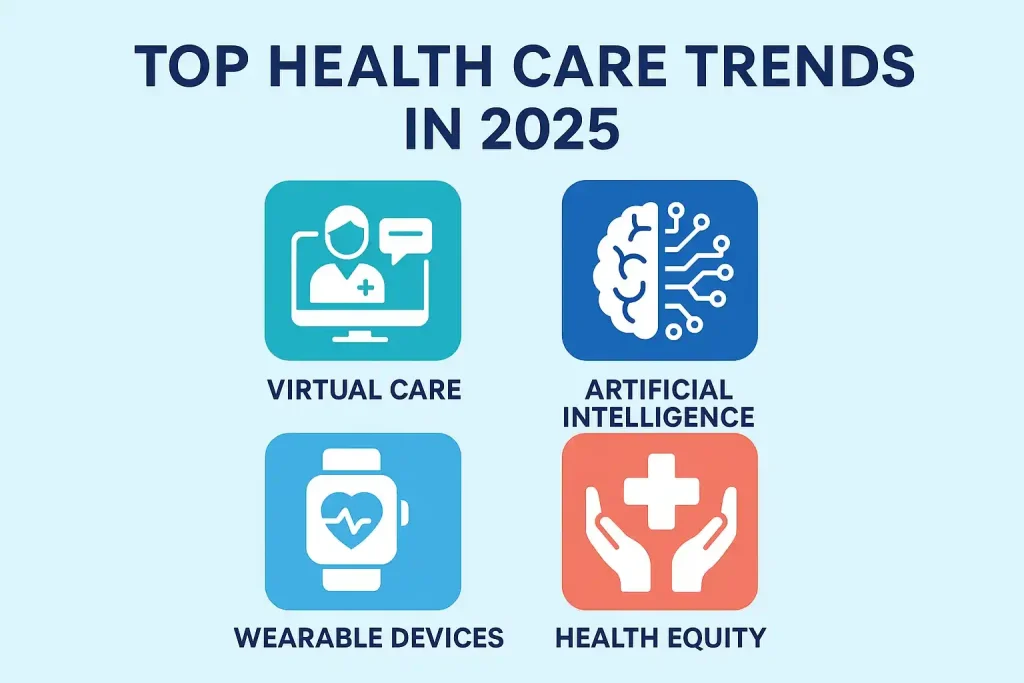Health Trends 2025: 7 Transformative Shifts Changing Healthcare

How cutting-edge technology, personalized approaches, and holistic thinking are revolutionizing healthcare and self-care
Introduction: The New Era of Proactive Health
As we navigate through 2025, the global health landscape is undergoing a remarkable transformation driven by technological innovation, generational shifts, and growing consumer awareness. The concept of “health” has expanded beyond mere absence of disease to encompass holistic well-being that integrates physical, mental, and emotional wellness into daily life. With younger generations prioritizing wellness more than ever and technological advancements making personalized healthcare accessible, we’re witnessing a paradigm shift from reactive treatment to proactive prevention.
Recent research reveals that 70% of global consumers now believe they’re proactive in managing their health, and 57% prioritize “aging well” more than they did five years ago 8. This evolution in mindset is catalyzing unprecedented innovation across the healthcare spectrum—from AI-powered diagnostics to mental health technology and personalized medicine. In this comprehensive exploration, we uncover the most significant health trends of 2025 that are reshaping how we think about, access, and experience wellness.
What Are the Defining Health Trends 2025?
The landscape of wellness is being reshaped by a convergence of technology, consumer demand, and a deeper understanding of holistic health. The defining health trends 2025 are not isolated phenomena but interconnected movements towards a more proactive, personalized, and accessible system. They are characterized by the seamless integration of AI into daily care, a long-overdue expansion of focus into women’s health and mental wellbeing, and a generational push for sustainability and ethical practices. Understanding these core shifts is key to navigating the future of your own wellness journey, as these health trends 2025 will influence everything from your doctor’s appointments to the products you buy.
1. The Technological Revolution in Healthcare
Artificial Intelligence and Precision Diagnostics
The integration of AI in healthcare disgnostics and machine learning into healthcare delivery represents one of the most significant advancements. These technologies are revolutionizing disease diagnosis by rapidly analyzing vast amounts of data with unprecedented precision. AI-driven diagnostics enable early detection of illnesses and more accurate prediction of personal health trends, allowing for timely interventions tailored to each patient’s unique health profile.

In practice, AI in healthcare disgnostics is now being used to reinterpret CT scans for acute aortic syndrome without contrast, significantly reducing diagnosis time and increasing accuracy 4. The technology is also powering a reclassification of multiple sclerosis progression, helping researchers understand how the disease transitions to severe stages and potentially how to reverse the process.
Telehealth: The New Normal
This is one of the Healthcare trends 2025 that is often overlooked. The COVID-19 pandemic fundamentally transformed how we access medical care, and by 2025, telehealth has become fully integrated into healthcare delivery systems. Patients can now consult virtually with healthcare professionals, receive follow-up care, and learn about disease prevention without visiting a hospital. This approach has been particularly valuable for reducing the risk of respiratory infectious diseases and expanding healthcare access to patients in remote areas or those facing mobility challenges AI in healthcare diagnostics will improve this.
Technological advancements through smartphones, wearable devices, and medical applications are just two healthcare trends 2025 that have made it easier for patients to schedule appointments and access diagnostic results with a simple tap on their devices. The adoption of telemedicine has also shown an unexpected environmental benefit—reducing greenhouse gas emissions associated with travel to medical facilities.
Wearable Health Technology: Beyond Step Counting
Wellness Trends 2025: Modern wearable technology has evolved far beyond basic fitness tracking. Today’s devices monitor a comprehensive range of health metrics including blood pressure, blood sugar levels, and early signs of health conditions. This easy access to personal health information empowers individuals to stay informed about their physical well-being and encourages them to take a more active role in maintaining their health.
*Table: Evolution of Health Wearables (2015-2025)*
| Year | Primary Capabilities | Health Monitoring Features | User Engagement |
|---|---|---|---|
| 2015 | Step counting, basic activity tracking | Calories burned, distance traveled | Manual logging, basic goal setting |
| 2020 | Heart rate monitoring, sleep tracking | Sleep stages, workout intensity | Notifications, reminders |
| 2025 | Continuous health monitoring, medical-grade data | Blood glucose, blood pressure, ECG, early anomaly detection | AI-powered insights, predictive alerts, healthcare integration |
The market demand for health-focused technology is strong, with 74% of consumers preferring tech products with extra health and wellness features over those without, and 63% believing these technologies effectively help improve their health.
2. Mental Health Technology: The Digital Therapeutics Boom
Accessible Mental Healthcare Solutions
Mental health technology 2025 has emerged as a crucial component of healthcare trends 2025 delivery, is playing a vital role in supporting individuals struggling with anxiety, post-traumatic stress disorder (PTSD), and other mental health challenges. AI-powered therapy apps and virtual reality treatments offer accessible, personalized care, allowing individuals to receive therapy from virtually anywhere and reducing barriers to seeking mental health support.
This expansion comes at a critical time, as statistics show that 1 in 4 people are dealing with mental health challenges in the United States alone 6. Unfortunately, Americans typically take 11 years to seek help for mental health issues, which often worsens their condition and increases the cost of care.
Measurement-Based Care and Digital Integration of Health Trends 2025
The field of behavioral healthcare is evolving toward measurement-based approaches that personalize treatment and track outcomes more effectively. In 2025, we’re seeing greater integration of mental health into primary care to improve access, along with advances in behavioral care navigation through personalized assistance 6.
The approach includes identifying the right methods of care, helping people find appointments, and providing 24/7 real-time clinical support. Adoption of virtual behavioral care continues to grow, with increasing uptake of predictive data models for earlier identification, provider matching, faster appointment times, and comprehensive follow-up.
Research confirms the value of these approaches, showing that outpatient behavioral health treatment is associated with medical and pharmacy savings of up to $2,565 in the 15 months after diagnosis. The greatest savings were observed for patients who had at least three sessions with a therapist—indicating the importance of what experts call “therapeutic alliance”.
3. Personalized and Precision Medicine
Genomic Medicine Comes of Age
Advanced genomic research is unlocking new avenues of understanding in human biology, providing foundational genetic insights that enhance our knowledge of disease mechanisms, particularly genetic disorders and cancers. By analyzing genetic data, healthcare professionals can now devise personalized treatments according to the unique genetic profiles of individuals.
2025 has witnessed significant advances in this field, including the development of a plasma proteomics-based biomarker panel that predicts amyotrophic lateral sclerosis (ALS) in presymptomatic individuals 4. Researchers have also made progress in understanding the genetic and molecular landscape of comorbidities in people living with HIV, illuminating molecular pathways that drive immune responses and comorbidities in this population 4.
Precision Medicine in Clinical Practice
The Royal Society of Thailand defines Precision Medicine as a medical approach that delivers highly effective and personalized health treatments by targeting specific factors such as genetics, environment, lifestyle, and more. This approach maximizes treatment efficacy while minimizing unwanted side effects, representing a revolution in modern medicine and healthcare.
Clinical applications of precision medicine are expanding rapidly. For instance, perioperative treatment with IDH inhibitors for patients with low-grade IDH-mutant glioma has shown promise in clinical trials 4. Similarly, GD2-targeting CAR T cells have demonstrated encouraging results in pediatric patients with high-risk metastatic, relapsed or refractory neuroblastoma, with an objective response rate of 66% 4.
4. The Focus on Women’s Health Expands
Beyond Reproductive Health
In 2025, the concept of women’s health has expanded significantly beyond its traditional association with pregnancy and reproductive health. The healthcare industry is acknowledging that women’s health encompasses a broad range of concerns that affect women differently or disproportionately 6.
Data analysis reveals that while women account for 50% of the commercially insured population ages 13 to 64, they represent 53% of patients utilizing health care and 57% of the total costs of care. Significantly, only 7% of health conditions evaluated were unique to women, yet 69% of conditions represented in claims data were more common or costlier in women, or both 6.
Integrated Care Models
There’s a growing push to make substantial improvements in women’s healthcare through empathetic, whole-person approaches that look beyond just symptoms. This includes developing a comprehensive understanding of the disproportionate impacts faced by women, the underlying causes of variations in their healthcare experiences, and enhancing service delivery and benefit design to better address women’s specific needs.
This trend toward integrated care models that focus on holistic patient care is becoming increasingly important across healthcare. A review of 34 studies found that such models reduce costs, help eliminate waste, improve health outcomes, and increase patient satisfaction 6.
5. Nutrition and Gut Health: Scientific Breakthroughs
The Microbiome Revolution
Gut health and microbiome research have emerged as critical areas of scientific focus in 2025. The gut microbiome is now recognized as a fundamental factor in overall health, influencing everything from digestion to mental well-being. Scientists are gaining a deeper understanding of how these microbial communities affect human health, leading to more sophisticated and effective probiotics and prebiotics.
Consumer interest in gut health is driving significant market changes, with 53% of consumers across 19 countries planning to buy more high-fiber foods in 2025, while around 40% plan to purchase more superfoods, high-protein plant-based foods, or probiotic foods.
Functional Nutrition as Preventive Medicine
The functional-nutrition space—consisting of food and beverages that deliver specific health benefits—is expanding rapidly. Approximately half of consumers in the United States, United Kingdom, and Germany, and two-thirds of Gen Z and millennials, report purchasing functional-nutrition products last year. In China, the adoption rate is even higher.
This trend is fueled by a shift toward viewing food as preventative medicine, with consumers becoming more aware of how their dietary choices affect their health. Rather than just seeking foods free from certain components like gluten or sugar, consumers are now looking for foods that include high-value components such as protein, nootropics, or turmeric.
6. Generational Shifts in Wellness Priorities
Millennials and Gen Z Driving Change
Younger generations are redefining the wellness landscape in 2025. Millennials and Gen Z approach wellness as a daily, personalized practice rather than a set of occasional activities or purchases. This shift is influencing the direction of the $2 trillion global wellness industry, which continues to expand beyond its core categories.
Nearly 30% of Gen Zers and millennials in the United States report prioritizing wellness “a lot more” compared with one year ago, versus up to 23% of older generations. This generational difference may stem from several factors: younger generations self-report higher levels of burnout and worse overall health compared with older people but are also more exposed to health-related content on social media.
The Wellness Consumer Segmentation
Research identifies five distinct wellness consumer segments:
- Maximalist optimizers (25% of wellness consumers): Digitally savvy consumers who experiment with a wide range of health and wellness products and conduct extensive research.
- Confident enthusiasts (11%): Fitness-obsessed consumers who heavily prioritize wellness and stick with what works for them.
- Health traditionalists (20%): Tend to be older consumers who care about health but prioritize simplicity and practicality.
- Health strugglers (24%): Place lower priority on health solutions and struggle with motivation despite having health goals.
- Wellness shirkers (20%): Less interested in monitoring their health, buy only essentials, and are very price-sensitive.
Table: Generational Wellness Priorities and Wellness Trends 2025
| Wellness Dimension | Gen Z Priority Ranking | Millennial Priority Ranking | Gen X/Boomer Priority Ranking |
|---|---|---|---|
| Sleep | 2 | 1 | 3 |
| Health | 1 | 2 | 1 |
| Appearance | 3 | 4 | 4 |
| Mindfulness | 4 | 3 | 5 |
| Fitness | 5 | 5 | 2 |
| Sexual Health | 6 | 6 | 8 |
| Nutrition | 7 | 7 | 6 |
7. Sustainable and Ethical Health Choices
Conscious Consumerism in Healthcare
Consumers are increasingly considering the environmental and ethical impacts of their health and wellness practices. This trend has led to the popularity of plant-based nutrition and eco-conscious fitness equipment, with increased demand for products and services that reflect these values.
Personal well-being and societal responsibility are becoming increasingly interlinked in consumers’ outlooks. Seventy percent of surveyed consumers believe it’s important that the health and wellness products they buy are also eco-friendly and/or ethically produced, and 71% are willing to pay more for wellness products with these attributes 8.
Environmental Health Concerns
Growing awareness of environmental health factors and Mental health technology 2025 is shaping consumer behavior and policy discussions. Research continues to reveal connections between environmental factors and health outcomes, such as the link between air pollution and bone health in postmenopausal women 5.
At the same time, consumers are becoming more skeptical of health claims by food companies (62%) and want more transparency in product labels (82%) 8. This demand for transparency extends beyond ingredients to include sourcing practices, environmental impact, and corporate ethics.
As we have explored, the defining health trends of 2025 present a future where healthcare is increasingly personalized, proactive, and integrated into the fabric of our daily lives. The convergence of AI-powered diagnostics, mental health technology, and precision medicine is creating a paradigm shift from a system of sick care to one of true health and wellness maintenance. These are not fleeting fads but fundamental health trends for 2025 that are reshaping industry standards and consumer expectations.
Successfully navigating this new era means understanding that these health trends 2025 has set in motion are deeply interconnected. The rise of generative AI in healthcare empowers the move towards value-based care, while the focus on the consumer experience is directly addressing long-standing healthcare workforce challenges by creating more efficient and satisfying systems for both patients and providers. Furthermore, the research propelling the top health trends 2025 underscores a critical insight: true innovation is measured not only by technology but by a renewed focus on human-centric care, holistic well-being, and equitable access.
Ultimately, the most important takeaway from our analysis of these health trends 2025 is empowerment. Whether you are a consumer making more informed choices about your health, a professional adapting to new tools, or an organization building for the future, understanding these dynamics is crucial. By embracing the personalized, preventive, and holistic model that these health trends of 2025 champion, we can all contribute to a system that prioritizes not just longer lives, but healthier, more fulfilling ones for everyone.
Conclusion: The Future of Health is Personalized, Preventive, and Holistic
As we look toward the remainder of 2025 and beyond, the health and wellness landscape continues to evolve at an accelerated pace. The convergence of technological innovation, generational mindset shifts, and growing health consciousness is creating a new paradigm in how we approach wellbeing.
The most successful healthcare strategies will be those that embrace personalization, leverage technology to enhance human care rather than replace it, and address the whole person rather than isolated symptoms. As consumers increasingly take charge of their health journey, they’re demanding more transparent, effective, and ethically produced products and services that align with their values.
The future of health is not just about living longer—it’s about living better. With the trends outlined above continuing to shape the healthcare landscape, we’re moving toward a world where healthcare is increasingly proactive, personalized, and integrated into our daily lives in seamless, empowering ways.
Whether through AI-powered diagnostics, mental health technology, personalized nutrition, or sustainable health practices, the innovations of 2025 are making holistic, effective healthcare more accessible than ever before. The challenge—and opportunity—for healthcare providers, innovators, and individuals alike will be to harness these trends in ways that promote not just longer lives, but healthier, more fulfilling ones for all. Learn more about this and other fitness and health related topic in our health hub.
The trajectory of healthcare is being defined by a surge in AI investment and an urgent need for robust cybersecurity, trends powerfully illustrated by industry analysis. According to PwC’s annual report, a staggering 77% of health executives now rank generative AI among their top three investment priorities, signaling a massive shift towards intelligent, data-driven care. Concurrently, as noted by experts at LexisNexis Risk Solutions, this digital transformation is forcing a critical modernization of cybersecurity protocols to protect patient data and ensure trust in new technologies.





